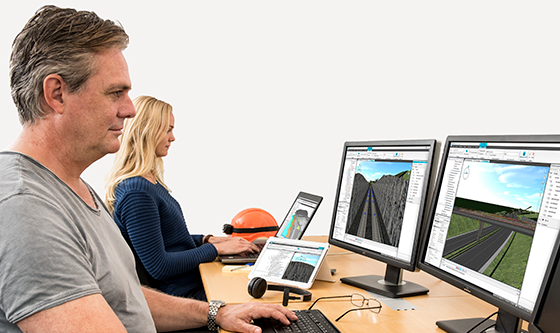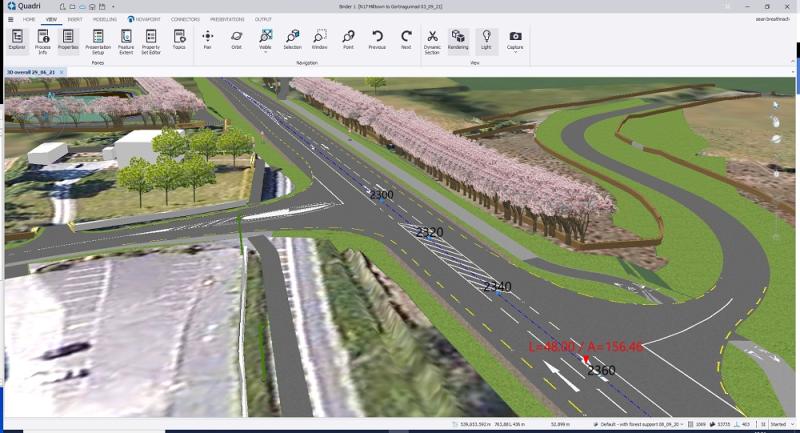Council delivering on civil infrastructure, with Trimble technology

Responsible for delivering civil infrastructure projects across Galway, the County Council’s engineering team has continued to digitise its approach in line with the ever-evolving industry, with Trimble Novapoint and Trimble Quadri now at the heart of its office.
At Galway County Council (Galway CC), the engineering office work on a variety of infrastructure projects within the local area, including new drainage routes, new roads, roundabouts and junctions, to name just a few. Having been a user of Trimble Novapoint for 17 years - the 3D design software designed specifically for civil infrastructure projects - the Council has continued to expand its software portfolio, with the latest addition of Trimble Quadri, the cloud-based collaboration platform.
Speaking about the initial decision to switch to Novapoint, back in 2004, Sean Breathnach, Senior Executive Engineer, said: “The software we had previously been using was pretty basic – it didn’t allow for effective collaboration and also wasn’t 3D compatible. We would have to manually add in the figures and setting out points for roadways, while also manually typing in coordinates. While it worked fine for its time, it gradually became more outdated as digital technology evolved.
“When we were introduced to Novapoint, we really liked its re-design and parametric capabilities, two things which were a big bonus for us.”

Today, a large percentage of Galway CC’s engineering work relates to pavement overlays, whereby the team will first carry out a survey of the existing ground and road structure – either a topographic survey or, more recently, a laser scan using Trimble hardware – and then use this data to re-design the surface and model the overlaying pavement. Road re-alignments and the re-design of junctions and roundabouts are also common occurrences for the engineering office.
Speaking about the benefits of Novapoint for this type of work, Sean commented: “Design changes are a common occurrence for us; even a small amendment can require a re-design. For example, it could be a change to the junction type, the positioning of a road entrance, the road width or its centre line – it all has a knock-on effect elsewhere in the design.
“This re-design process was made a lot easier and more streamlined with Novapoint and its 3D parametric modelling capabilities, saving our engineers valuable time. With all elements within the model intelligent linked and interconnected, any design change made is automatically reflected elsewhere, thanks to its connected parameters.
“Another benefit of the 3D modelling software is the visualisation that it provides. While 2D drawings are still an important and valuable part of the engineering and construction process, when working solely in 2D we would often find that road heights on site hadn’t been considered or accounted for correctly in the design drawings. For example, an entrance road or a side road would be on a different level. Now, with the 3D model, you’re able to clearly see the different surface depths and heights, with this enhanced visualisation aiding a higher level of accuracy.
“Accuracy at this initial engineering stage is essential too, with a lot of the contractors and parties further down the project timeline relying heavily on the information that we provide.”

Galway County Council’s latest software acquisition is Quadri, a cloud-based platform developed by Trimble to offer a common data environment for infrastructure BIM projects, creating real-time collaboration between field and office.
Speaking about the platform, Sean said: “While Quadri was perhaps primarily developed by Trimble to aid effective external collaboration between project partners and stakeholders, it has had a really positive impact on the way that we collaborate and communicate internally, within the Galway CC team.
“On any project, we will often have different designers and engineers all working on different aspects of the same job, such as one modelling the junctions, one the drainage and another the side or main road. With Quadri and the collaboration it enables, we can all work in a more connected manner. For example, if one of our engineers encounters a problem or design issue, they can easily share the model around the rest of the team and work closely together to resolve it. As well as enabling effective problem solving, this more coordinated and collaborative way of working has also resulted in potential errors or mistakes being caught early.
“Quadri was also especially valuable during the Coronavirus pandemic, given the remote working restrictions. Even now, with our team split between the office and home, we can still work efficiently and productively together as one, regardless of our location.”
As well as the internal collaboration within a company, Quadri also facilitates effective coordination and connectivity between all parties involved on a project, something that Galway CC’s engineering office has seen increased demand for.
Sean explained: “As engineers within the civil infrastructure sector, we are increasingly receiving requests from the contractor for the 3D model file. It’s clear that there is a genuine want and a genuine interest to progress with BIM, to make use of the 3D model and to work in this more digitised manner. Personally, I think it’s really positive to see this upwards push on BIM, with demand coming from the bottom of the construction chain upwards.
“Part of this push may relate to the rise of smart machinery and excavators on site. With BIM and the interoperability and integration it can enable, contractors can automatically transfer GPS data from the 3D model to the smart machinery, instructing the excavators on where to dig, how long for and how deep – again saving time and money.
“This external collaboration is definitely something that we want to work on next as an engineering office, utilising digital software and cloud-based platforms such as Trimble Quadri to help improve the way that we work and coordinate with third parties.”